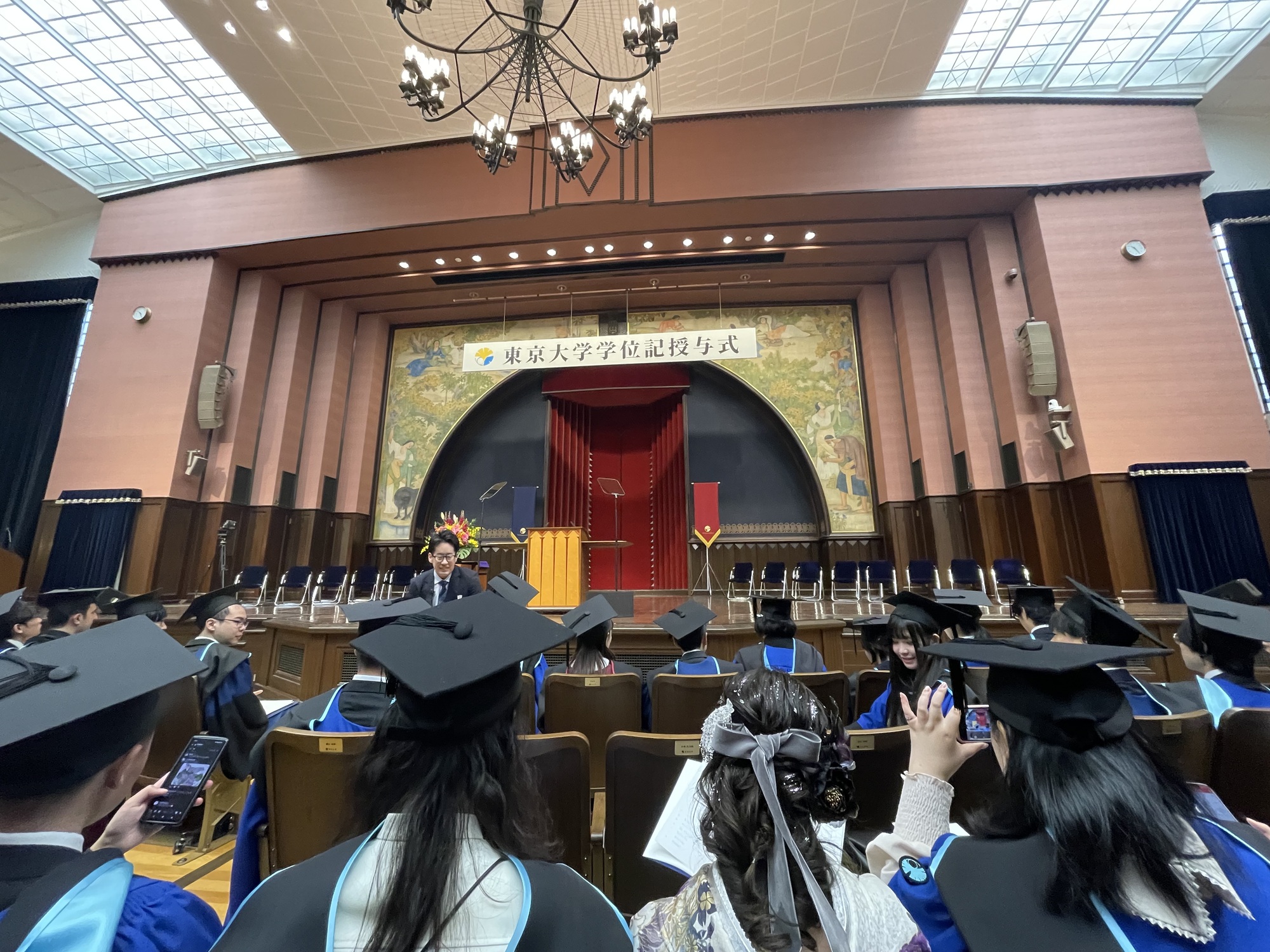Blog
Thank You, and Farewell to My Master's Life: A Guide to the Hirabayashi Lab

Hello, and good evening.
My name is Daichi Ueno, and I have recently completed my master’s degree at the Hirabayashi Laboratory.
On March 24, 2025, we had our graduation ceremony in the morning at the Hongo Campus, followed by the completion ceremony for our department—Department of Ocean Technology, Policy, and Environment—in the afternoon at the Kashiwa Campus.

Looking back, the past two years have flown by.
Every day was filled with new discoveries and inspiration from Professor Hirabayashi, my labmates, and juniors. I had an incredibly fulfilling research life, for which I am deeply grateful.
As a small token of appreciation, I would like to briefly introduce the Hirabayashi Lab and highlight some of its strengths that I experienced during my time there.
About the Hirabayashi Lab
The Hirabayashi Laboratory specializes in floating body research within the field of Ocean Engineering.
We conduct studies to evaluate hydrodynamic forces generated by natural marine environments such as waves, currents, and wind, and perform floating body response analyses to improve safety and support practical implementation.
In recent years, we have especially focused on floating offshore wind turbines (FOWTs), a promising form of renewable energy, and the lab has been actively engaged in their research and development.
Strengths of the Hirabayashi Lab
Allow me to share what I personally found to be the lab's greatest strengths:
A well-equipped and supportive research environment
A wealth of accumulated research and academic legacy
Strong partnerships with marine-related industries
1. A Well-Equipped and Supportive Research Environment
What first impressed me was the lab’s outstanding research environment.
In our department, each faculty member supervises only a few students, creating a close-knit academic setting.
Thanks to this small-group system, it was easy to consult with professors about research questions and challenges.
Weekly seminars are a core part of the lab, where we present progress, share concerns, and receive constructive feedback.
Professor Shinichiro Hirabayashi, true to his name, is an incredibly kind and thoughtful mentor who treats everyone with equal respect.
Whenever I felt stuck in my research, his advice often helped me discover new perspectives and get back on track.
The lab also boasts excellent research facilities, including experimental tanks and powerful computing systems.
We use a variety of numerical simulation tools, such as:
OpenFOAM
Fluent
Ansys AQWA
WAMIT
OrcaFlex
These allow us to approach our research from both experimental and computational perspectives.
2. A Wealth of Accumulated Research and Academic Legacy
The Hirabayashi Lab has a long-standing tradition of high-quality research.
In particular, many former students have conducted foundational studies on Vortex-Induced Motion (VIM), creating a strong base of knowledge and data.
This rich archive of prior research makes it easier to start new studies and increases the chances of producing meaningful results.
Moreover, research themes range from theoretical to practical applications, allowing each student to explore their own interests and strengths.
3. Strong Partnerships with Industry and National Projects
Another great strength of the Hirabayashi Lab is its strong ties with marine development industries and national-level projects.
The lab frequently engages in joint research with companies, allowing students to tackle real-world problems that reflect current industry needs.
These collaborations often lead to valuable networking opportunities and help shape future career paths.
Many graduates have gone on to work in trading companies, power companies, oil and gas firms, shipping and shipbuilding industries, and marine consulting firms.
In some cases, these graduates have even reconnected with the lab through collaborative research at their companies.
Furthermore, Professor Hirabayashi is actively involved in national projects such as those run by NEDO, participating in guideline development and serving on expert committees.
His efforts bridge academic research and real-world application, and I learned a great deal from his example of how research can contribute to society.
In Closing
If I had to point out one (somewhat humorous) challenge—it might be that the lab tends to attract mostly male students every year (laughs).
This may be due to the technical nature of topics like fluid dynamics and floating structures, which can seem a bit niche or intimidating.
Additionally, because ocean engineering deals with phenomena that are far removed from everyday life, it might be harder to imagine or relate to.
However, ocean engineering is a multidisciplinary field that requires knowledge across various areas.
Implementing solutions in society involves not only technical aspects but also understanding of law, economics, and social systems.
It is a field where diverse perspectives and backgrounds come together to generate new ideas and innovations.
As for me, I came from a different university and researched a completely different field during my undergraduate years.
I had no prior experience with water tank experiments or numerical simulations, but by going through repeated trial and error, I was able to develop new skills and grow as a researcher.
Through exchanges with students from various backgrounds, I was also inspired in many ways.
The Hirabayashi Lab welcomes students from all walks of life. If you’re even a little bit interested, I encourage you to contact the professor directly (you can find the email address on the lab website).
I wish the Hirabayashi Lab continued success and growth.
Thank you for an unforgettable two years, and I look forward to staying in touch.
March 31, 2025
Daichi Ueno
Master’s Program Graduate
Department of Ocean Technology, Policy, and Environment
Hirabayashi Laboratory, The University of Tokyo
Latest Blog
-
2025.07.08The results of Floating Wind Challenge 2025#FloaringWindChallenge2025 #Floating Offshore Wind Turbine #Nippon Foundation
-
2025.06.14A report on the attendance at the annual spring meeting of Japan Society of Naval Architects and Ocean Engineers (JASNAOE) in Matsuyama
-
2025.04.17Floating Wind Challenge 2025#Hirabayashi Lab #FOWT #FloaringWindChallenge2025 #International Competition